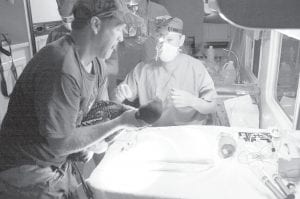As the loons make their return journey north to Minnesota from the Gulf of Mexico this year, wildlife watchers are following them closely.
Researchers are looking for signs the loons may have been harmed by the Gulf oil spill.
In July 2010, Kevin Kenow supervised a team of scientists from around the country as they launched a canoe onto a lake at St. John’s University in Collegeville, MN. They were there at night to capture loons and outfit them with satellite transmitters.
“Between the calls and the lights, it pulls the birds’ attention enough that we’re able to move in on it and scoop it up with the landing net,” he said.
Carrol Henderson from the Minnesota Department of Natural Resources (DNR) non-game wildlife program was on the lake that night. He said the satellite transmitters they used have to be implanted internally.
“You can’t put a harness on a bird like a loon, because it impairs their diving ability,” he said.
A surgeon from Florida was on the scene. He’d come north in his veterinary MASH unit, housed in a travel trailer. He implanted a small transmitter into a loon’s abdominal cavity. An 8-inch wire antenna provides the connection with the satellites.
The wire sticking out the back makes the loon appear as if it’s sporting a jaunty antenna—which it is.
The bird also gets a geolocator tag fastened to a leg band. This records the bird’s movements and also atmospheric pressure, showing how deep the loon dives for food.
Henderson and other experts think the Minnesota birds most at risk from last year’s Gulf oil spill are loons and white pelicans. Young loons spend nearly three years in the Gulf, and white pelicans spend one year there before they fly north.
“So the loons that hatched in Minnesota in 2008 and 2009 were down in the Gulf during the time of the oil spill, and we don’t know how many could have been lost,” he said.
More than 100 loons were found dead or dying after the spill, but Henderson said they’re dense birds, more likely to sink to the bottom than float to shore. There could be longer-term risks, too, he said.
“Loons, which can dive to almost 200 feet to feed— a lot of their feeding is actually on the bottom—if they’re feeding on bottom creatures that have been exposed to oiled sediment, this could be affecting the food chain or their metabolism in the long term as well,” he said.
The scientists are taking blood samples of this and other loons, looking for residues of petroleum or the chemical dispersants used after the spill.
Right now they don’t have any particular expectations, but they think it’s possible the time the birds spent in the Gulf could affect their survivability, and their reproductive success.
On the DNR’s web site you can track the movements of the St. John’s loon since it was outfitted with the transmitter. At the office, the DNR’s Lori Naumann sits in front of a computer screen and shows us what they’ve learned about the loon’s movements.
Each dot on the map represents a day in the life of the loon. The map shows the loon spent a lot of time paddling around the lake at St. John’s—until mid-October 2010. The bird is then tracked to Lake Michigan where it stayed for awhile before flying down to the Gulf of Mexico in early December.
When it flies back up this spring, the research team hopes to catch it again, download the GPS data, and check its blood.
They plan to fit more loons with transmitters and GPS tags this summer. They want people who find dead loons to contact the DNR right away so they can try to figure out the cause of death. And they’re conducting similar in-depth studies of white pelicans.



Loading Comments